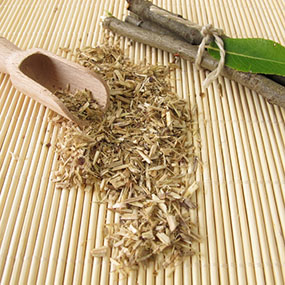The Best Herbs for Arthritis and Pain Relief
Herbal remedies can be a safer, less expensive alternative to pharmaceuticals, and you can grow many of them in your backyard. Rather than herbs being too weak, many drugs are too strong, and using
herbal remedies may help allleviate your symptoms without as many side
effects.
Alterative herbs help cleanse metabolic waste
products and toxins from our body, and are a staple of herbal medicine.
Alteratives work by supporting the natural cleansing functions of the
kidneys, large intestines, increase blood flow and aid lymph drainage.
Allowing these wastes and toxins to circulate throughout the body is a
cause of inflammation and, when the body is attempting to stem
inflammation, it’s not able to do much else in order to support our
health. Here are herbs to help stem inflammation and aid the body
in its detoxing efforts
Flax seeds
Flaxseed
is one of the best vegan sources of Omega-3 (ALA), which is so
important to a strong immune system and for fighting inflammation (the
vegan bit is important because animal fats often lead to inflammation in
arthritis sufferers). Try to include two tablespoons of flaxseeds or
flaxseed oil in your daily diet. Note: do not heat or cook seeds or oil.
Also, if you suffer from a digestive condition such as Irritable Bowel
Syndrome (IBS), use the oil rather than the seeds—they could irritate
your condition.
Boswellia
Boswellia
is praised by alternative medicine practitioners for its anti-inflammatory
capabilities. It is derived from the gum of boswellia trees, which are
indigenous to India. Also called frankincense, this herb is thought to work by
blocking leukotrienes. Leukotrienes are substances that can attack healthy
joints in autoimmune diseases such as rheumatoid arthritis. The NCCAM acknowledges promising evidence of boswellia
in animal studies, but notes a lack of human trials. Boswellia is available in
tablet form, as well as topical creams.
.

Cat’s Claw
Cat’s
claw is another anti-inflammatory herb that may reduce swelling in arthritis.
This herb is from a tropical vine, and its usage dates back to Inca
civilizations. Traditionally, cat’s claw is used to boost your immune system.
In recent years, the immunity powers of the herb have been tried in arthritis. The
downside is that cat’s claw may overstimulate the immune system, potentially
making arthritis pain worse. According to the University of Maryland
Medical Center (UMMC), studies have shown that cat’s claw can help with osteoarthritis
pain and RA swelling. However, there’s no proof that this herb can prevent
furthe

Turmeric
Turmeric
is an extremely effective anti-inflammatory herb, and thus an effective
pain reliever. It contains at least two chemicals (curcumin and
curcuminoids) which decrease inflammation (and are very much like the
oft-prescribed non-steroidal anti-inflammatory drugs, or NSAIDs).
Incidentally, this anti-inflammatory effect is also why turmeric is
often recommended for treatment of cancer, cataracts and Alzheimer’s.
While
you can totally add this spice to your daily diet, you will need to
take turmeric in supplement form in order to experience the full
medicinal benefits. When cooking, try adding black pepper or dried
ginger to help activate turmeric. The herb can also be applied topically
to relieve pain.
Eucalyptus
Like
aloe vera, eucalyptus is widely available in western markets. It is used in oral
medications, and topical oil extracts are used for a variety of conditions.
Topical forms of eucalyptus leaves are used to treat arthritis pain. According
to UMMC, these plant leaves
contain tannins, which may be helpful in reducing swelling and the resulting pain
that arthritis causes. Some users follow up with heat pads to maximize the
effects of eucalyptus on swollen joints.

Licorice
Licorice
acts much like your body's own natural corticosteroids (which reduce
inflammation). Licorice decreases free radicals at the site of
inflammation and inhibits the enzyme production that's involved in the
inflammatory process. Glycyrrhizin is the component in licorice which
blocks and relieves inflammation. It also supports the body's release of
cortisol (which suppresses the immune system, easing the pain and
occurrence of arthritis), but it also inhibits some of the side effects
of cortisol (such as adrenal fatigue and anxiety). Use in supplement
form or as a tea.
Please note: Licorice is not a
good remedy for those with blood pressure issues. People who regularly
take large amounts of licorice (20 grams/day or more) may experience
serious side effects such as headache, high blood pressure, and heart
problems. If you already have high blood pressure, heart or kidney
disease, or low potassium (hypokalemia), please avoid the herb
altogether.
Thunder God Vine
Thunder
god vine is one of the oldest herbs used in Chinese medicine. Extracts from skinned roots are known for suppressing
an overactive immune system, making thunder god vine a possible alternative
candidate for treatment of autoimmune diseases such as RA. It is best used in
topical form applied directly to the skin. Thunder god vine may work best when
used with conventional RA medications. Use extreme caution with this herb, as
it can be poisonous if extracts are derived from other areas of the vine.

Willow Bark
Willow
bark is one of the longest-used herbs in treating inflammation. In fact,
patients during Hippocrates’ time chewed on willow bark to help treat
inflammatory conditions. UMMC reports that the herb
shows promise in relieving osteoarthritis-related joint pain, particularly in
the knees, back, hips, and neck. This treatment is taken orally, either by tea
or tablet. Getting the right dose is crucial, as an overdose can cause rashes
and other forms of inflammation.

the best treatment for arthritis is a diet filled with fresh produce, essential fatty acids, and fiber (and reducing or eliminating foods that cause an inflammatory response such as fried foods, animal fats, dairy, and anything else which might cause an allergy sensitivity). Yoga (especially Yin Yoga) and gentle stretching go a long way toward arthritis prevention and pain relief by opening joints, and encouraging the distribution of synovial fluid, which lubricates the joints.
WARNING: No information on this website is
intended to diagnose, treat, cure or prevent any disease. This home
remedies site is intended to be archival in nature. The natural
remedies here are submitted by numerous people from around the world,
and it is impossible to verify every remedy. As such these home remedies
should be used for academic purposes only. Never use any home remedy
or other self treatment without being advised to do so by a physician.
No comments:
Post a Comment